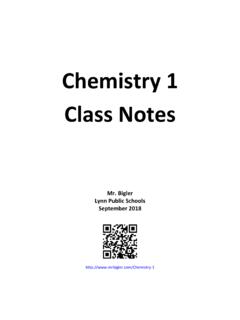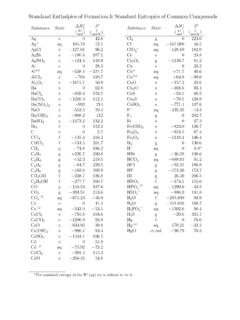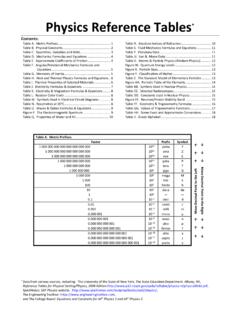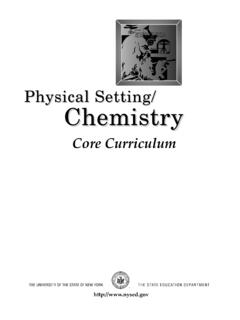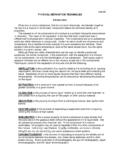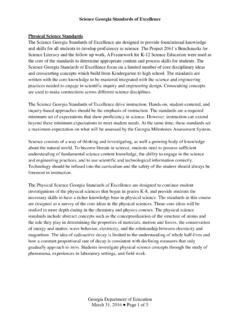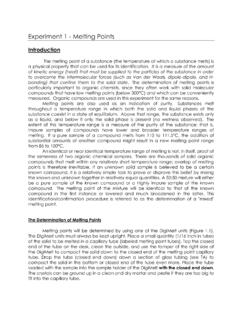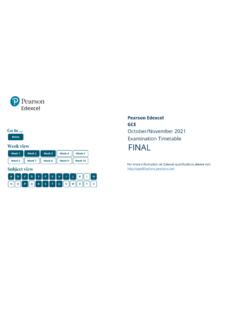Transcription of Chemistry Reference Tables - Mr. Bigler
1 Periodic table of the Elements Copyright 2009 2018 Jeff Bigler . Attribution-NonCommercial-ShareAlike International License. You are free to share and/or adapt this work for non-commercial purposes, with appropriate attribution, under an identical, similar, or compatible license. See for more information. 1 1atomic # 29+2,1 ions commonly formed2atomic symbol English element name atomic mass (rounded)3+14+25+36 47 38 29 110 Gases Liquids Metalloids11+112+213+314 415 316 217 11819+120+221+322+4,3,223+5,2,3,424+3,2, 625+2,3,4,6,726+3,227+2,328+2,329+2,130+ 231+332+4,233 334 235 13637+138+239+340+441+5,342+6,3,543+7,4, 644+4,3,6,845+3,4,646+2,447+148+249+350+ 4,251+3,552 253 15455+156+271+372+473+574+6,475+7,4,676+ 4,6,877+4,3,678+4,279+3,180+2,181+1,382+ 2,483+3,584+4,2858687+188+2103+310410510 610710810911011111211311411511611711857+ 358+3,459+3,460+361+362+3,263+3,264+365+ 3,466+367+368+369+3,270+3,2lanthanides(r are earth metals)
2 89+390+491+5,492+6,3,4,593+5,3,4,694+4,3 ,5,695+3,4,5,696+397+3,498+399+3100+3101 +3,2102+2,3actinidesCommon Polyatomic IonsSiO4 4acetatephthalateC8H4O4 2orthosilicateO2 2 HPO4 2phosphatePO4 3boratehydrogen sulfateHSO4 1CH3 COO 1hydrogen phosphatedihydrogen phosphateH2PO4 1chloriteClO2 1periodateIO4 1cyanideCN 1hydrogen carbonateHCO3 1permanganatearsenateC2H3O2 1CO3 2 ClO 1nitrateNO2 1bromateBrO3 1BO3 3 AsO4 3dichromateCr2O7 2carbonateB4O7 2sulfitesulfateSO4 2chromateCrO4 2SO3 2peroxidetetraborateNO3 1hydroxideOH 1iodateIO3 1thiocyanateSCN 1cyanateOCN 1nitriteperchloratechloratehypochloriteC 2O4 2 SiO3 2oxalatesilicateMnO4 1 ClO4 1 ClO3 167 5f 5d 6d6s7sbariumRafranciumammoniumNH4+1hydro niumH3O+ AK1s2s3sHLiPeriod12315V A16VI A2II A3 III B4IV BmagnesiumB7 VII B8 VIII B7p6p12II B9 VIII B5p10 VIII A17 VII
3 A14IV B11I B6VI 4f Chemistry Reference Tables1 table A. Standard Temperature and Pressure .. 2 table B. Selected Units .. 2 table C. Selected Prefixes .. 2 table D. physical Constants for Water .. 3 table E. Vapor Pressure and Density of Water .. 3 Figure F. Phase Diagram for Water .. 3 table G. Solubility Guidelines .. 4 table H. Ksp Values for Some Insoluble Salts at 25 C .. 4 Figure I. Solubilities of Selected Compounds .. 4 table J. Number Prefixes .. 5 table K. Polyatomic Ions .. 5 table L. Flame Test Colors .. 5 table M. Aqueous Ion Colors .. 5 table N. Colors of Assorted Compounds .. 5 table O. Common Acids .. 6 table P. pKa Values for Common Acids .. 6 table Q. Common Bases .. 6 table R. Common Acid-Base Indicators.
4 6 table S. Symbols Used in Nuclear 7 table T. Selected Radioisotopes .. 7 table U. Constants Used in Nuclear Chemistry .. 7 Figure V. Neutron/Proton Stability Band .. 7 table W. Activity 8 table X. Std. Reduction Potentials .. 8 table Y. Selected Properties of the Elements .. 9 Figure Z. Bonding Triangle .. 11 table AA. Bond Dissociation Energies & Bond Lengths .. 12 table BB. Thermodymanic Data .. 13 table CC. Some Common & Equivalent Units and Approximate 14 table DD. Selected Formulas and Equations .. 15 table A. Standard Temperature and Pressure table B. Selected Units Name Values Name Symbol Quantity Standard Pressure 1 atm 760 torr kPa meter (SI) m length Standard Temperature 0 C 32 F centimeter cm atm = atmosphere kilogram (SI) kg mass Torr = millimeter of mercury (mm Hg) gram g kPa = kilopascal Pascal (SI derived) Pa pressure C = degree Celsius atmosphere atm F = degree Fahrenheit mm of mercury mm Hg K = kelvin Torr Torr Kelvin (SI) K temperature table C.
5 Selected Prefixes degree Celsius C Factor Number of Units Prefix Symbol amt of substance (SI) mol mole 106 1,000,000 mega- M Joule (SI derived)) J energy 103 1,000 kilo- k kilocalorie kcal 10 1 deci- d second (SI) s time 10 2 centi- c liter L, volume 10 3 milli- m part per million ppm concentration 10 6 001 micro- (or u) molarity M, mol concentration 1 adapted from: The University of the State of New York. The State Education Department. Albany, NY. 12234. 2002 Edition. Reference Tables for physical Setting/ Chemistry . Chemistry Reference Tables p. 3 table D. physical Constants for Water Freezing Point @ 1 atm 0 C = K Boiling Point @ 1 atm 100 C = K Heat of Fusion J/g Heat of Vaporization 2270 J/g Specific Heat Capacity (Cp) J/g C Freezing Point Depression Constant (Kf) C/m Boiling Point Elevation Constant (Kb) C/m table E.
6 Vapor Pressure and Density of Water Figure F. Phase Diagram for Water Temp ( C) Pvap (kPa) density (g/cm3) 1 4 5 10 15 20 25 30 35 40 45 50 55 60 65 70 75 80 85 90 95 100 105 Chemistry Reference Tables p. 4 table G. Solubility Guidelines Ions That Form SOLUBLE Compounds EXCEPT with Ions That Form INSOLUBLE Compounds EXCEPT with Group I ions (Li+, Na+, etc.) carbonate (CO32 ) Group I ions, ammonium (NH4+) ammonium (NH4+) chromate (CrO42 ) nitrate (NO3 ) phosphate (PO43 ) hydrogen carbonate (HCO3 ) sulfite (SO32 ) chlorate (ClO3 ) sulfide (S2 ) Group I ions, Group II ions, NH4+ perchlorate (ClO4 ) acetate (C2H3O2 or CH3 COO ) Ag+ hydroxide (OH ) Group I ions, NH4+, Ba2+, Sr2+, Tl+ halides (Cl , Br , I ) Ag+, Cu+, Pb2+, Hg22+ oxide (O2 ) sulfates (SO42 ) Ca2+, Sr2+, Ba2+, Ag+, Pb2+ table H.
7 Ksp Values for Some Insoluble Salts at 25 C Figure I. Solubilities of Selected Compounds Compound Ksp MgCO3 10 5 PbCl2 10 5 BaF2 10 6 CuCl 10 6 PbI2 10 8 AgOH 10 8 BaCO3 10 9 CaCO3 10 9 SrCO3 10 10 AgCl 10 10 BaSO4 10 10 CaF2 10 11 Mg(OH)2 10 11 Ag2 CrO4 10 12 CuI 10 12 AgBr 10 13 PbSO4 10 13 PbCO3 10 13 Mn(OH)2 10 14 PbCrO4 10 14 Fe(OH)2 10 14 AgI 10 16 Zn(OH)2 10 18 FeS 10 18 HgCl 10 18 ZnS 10 23 PbS 10 28 CdS 10 29 Al(OH)3 10 34 CuS 10 36 Fe(OH)3 10 36 Ag2S 10 50 HgS 10 53 Chemistry Reference Tables p. 5 table J. Number Prefixes Number Inorganic Organic Number Inorganic Organic 1 mono- meth- 6 hexa- hex- 2 di- eth- 7 hepta- hept- 3 tri- prop- 8 octa- oct- 4 tetra- but- 9 nona- non- 5 penta- pent- 10 deca- dec- table K.
8 Polyatomic Ions ion formula ion formula ion formula ion formula americyl AmO22+ ammonium NH4+ cyanate OCN dichromate Cr2O72 carbonyl CO2+ hydronium H3O+ thiocyanate SCN imide NH2 thiocarbonyl CS2+ iodyl IO2+ selenocyanate SeCN molybdate MoO42 neptunyl NpO22+ nitrosyl NO+ tellurocyanate TeCN peroxide O22 plutoryl PuO22+ thionitrosyl NS+ hydroxide OH oxalate C2O42 selinyl SeO2+ phosphoryl PO+ iodate IO3 phthalate C8H4O42 selenoyl SeO22+ thiophosphoryl PS+ methanolate CH3O selenate SeO42 thionyl / SO2+ phospho PO2+ methanethiolate CH3S disulfide S22 sulfinyl acetate CH3 COO ethanolate C2H5O sulfate SO42 sulfonyl / SO22+ amide NH2 permanganate MnO4 thiosulfate S2O32 sulfuryl hydroxylamide NHOH nitrate NO3 dithionate S2O42 uranyl UO2+ azide N3 superoxide O2 silicate SiO32 vanadyl VO2+ hydrazide N2H3 tetraborate B4O72 borate BO33 mercury (II) Hg2+ bromate BrO3 carbide C22 arsenate AsO43 mercury (I) Hg22+ chlorate ClO3 carbonate CO22 phosphate PO43 cyanide CN chromate CrO42 orthosilicate SiO44 table L.
9 Flame Test Colors Element Color Element Color Element Color Ba yellow-green K pink Pb blue Ca orange-red Li fuchsia Sb pale green Cu blue-green Mg bright white Sr red Fe gold Na yellow Zn blue-green table M. Aqueous Ion Colors Ion Color Ion Color Cu+ green V2+ violet Cu2+ blue V3+ blue-green Fe2+ yellow-green CrO42 yellow Fe3+ orange-red Cr2O72 orange Cr3+ violet [Cr(NO3)3] to green [CrCl3] Cu(NH3)42+ dark blue Ni2+ green FeSCN2+ red-brown (wine-red to dark orange) Mn2+ pink Co2+ pink Mn7+ purple ( , the MnO4 ion) CoCl42 blue Pb3+ blue-green (Pb2+ and Pb4+ are clear) Ti(H2O)63+ purple table N. Colors of Assorted Compounds Compound Color Compound Color F2 pale yellow gas NO colorless gas Cl2 green-yellow gas NO2 brown gas Br2 red-brown liquid metallic sulfides sulfides of transition metals tend to be black I2 dark metallic solid; dark violet vapor S8 yellow odorous solid metallic oxides oxides of colored transition metals tend to be colored PbI2 bright yellow precipitate Fe2O3 reddish-brown (rust) Chemistry Reference Tables p.
10 6 table O. Common Acids table P. pKa Values for Common Acids Formula Name Acid pKa Conj. Base HCl (aq) hydrochloric acid H2O OH HNO3 (aq) nitric acid HPO42 PO43 H2SO4 (aq) sulfuric acid HCO3 CO32 H3PO4 (aq) phosphoric acid NH4+ NH3 H2CO3 (aq) carbonic acid HCN CN HC2H3O2 (aq) or CH3 COOH (aq) ethanoic acid (acetic acid) H2PO4 HPO42 H2S HS H2CO3 HCO3 table Q. Common Bases CH3 COOH CH3 COO Formula Name HCOOH HCOO NaOH (aq) sodium hydroxide HNO2 NO2 KOH (aq) potassium hydroxide HF F Ca(OH)2 (aq) calcium hydroxide C6H8O7 (citric acid) C6H7O7 NH3 (aq) aqueous ammonia H3PO4 H2PO4 table R. Common Acid-Base Indicators HSO4 SO42 Indicator pH Range of Color Change Color Change HNO3 NO3 H3O+ H2O bromophenol blue yellow purple HCl Cl methyl orange red yellow HBr Br bromocresol green yellow blue HI 10 I methyl red red yellow HClO4 10 ClO4 litmus red blue H2SO4 12 HSO4 bromothymol blue yellow blue phenol red yellow red Any acid with a pKa value less than 0 is a strong acid; any base with a pKa value greater than 14 is a strong base.
